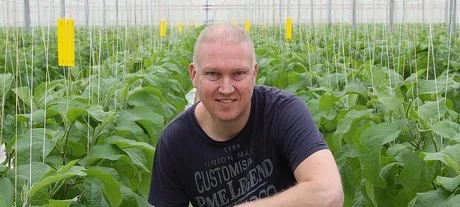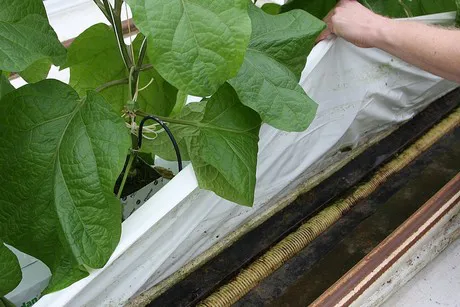Boekestijn EggPlants in De Lier (Netherlands) grows eggplants on Grodan rock wool on 4.3 hectares. The mats are placed loose on the ground, not on gutters, hanging or not. Peter Boekestijn: "Because of the contact with the ground, the mat temperature is more even, and therefore the growth is more generative. Moreover, at the end of the cultivation season we have enough space left for a good production in the low greenhouse with 4.5 meter plant height."

On both sides of the row of rock-wool mats, on the surface in the ground, drainage hoses are placed in a black plastic gutter to carry away the drainage water (photo below). The drainage water is transported through a central tube to a drainage well, and from there it is pumped to the waste-water silos. Then it will be treated with a UV sanitizer and stored in clean-water silos, so it can be used for cultivation again. Also because of the use of liquid fertilizer without ballast substances, Boekestijn is able to grow closed.

At the start of the cultivation season, after the mats have been moistened and drained, 100 m3 drainage water is pumped through the purification system to the sewer buffer silo, with a capacity of 18 m3 per day (75 m3 capacity). This silo is drained using telemetry, the central control system in the Westland, to the sewer. Next season, the eggplant grower will determine whether this waste flow of water can be limited by using a different way of draining and using up the mats.
Mixing irrigation water
The eggplant grower continues: "When insufficient rain falls during the cultivation season, like last summer, we start to mix in tap water when the rainwater basin of 6000 m3 has been emptied to a third. The mains connection delivers 125 m3 per day. The total crop vaporization is maximally 250 m3 per day. In case of lasting drought, we can run out of rain water fairly quickly, and then ditch water is mixed in. This water first passes a UV sanitizer at the highest setting. The ditch water is of good quality, and last summer it has an EC value of 0.8 mS/cm."
Boekestijn: "In a year we have to mix in a lot of water, like in 2018, we saw the sodium levels rise in three months to even 14 or 15 mmol per liter. This is extremely high, but it had no visible effect on the crop or fruit quality. At the peak, in early August, we did decide to transport 200 m3 drainage water, which has been processed by the purification system in 2 weeks, from the buffer silo to the sewer." The grower indicates these are exceptions and most of the years he does not have to drain any excess. Several crops are now being researched for growing with higher sodium levels.
Empty and clean silos
Besides a silo for waste and clean water, there is a third silo that is important to the entrepreneur. "This one is intended for storing rinse water from the filters, but also the condense water of the greenhouse. And in case of water shortage, also tap water and/or decontaminated ditch water." Inside, there are three more silos for storing irrigation water.
Starting four weeks before the end of the cultivation, the six silos of 135 m3 each are emptied as much as possible. At crop rotation, 10 to 15 percent remains in the silo. This is about 150 m3 in total, which is transported through the purification system to the sewer. Boekestijn: "During the cultivation change, 200 m3 water enters the system due to the cleaning of the glass and other work. This is transported to the waste silo, and through the purification system to the sewer."
The eggplant grower cleans all silos every year. Starting a new season with dirty silos is unacceptable to him. "Cleaning makes sure we can run a full season without any problems. The sludge water is transport by tubes to an underground container. A pump makes sure it gets to the sewer buffer silo. A special company empties these silos and disposes of the sludge."
Purification collective
The entrepreneur is (in spite of having an individual purification installation) member of a purification collective, because they have room for initiatives for a proper irrigation water supply in the Westland. "It would be great if the collective could supply low level sodium water in a few years."
He does have a critical remark. "The horticultural sector supplies clean, purified water to the sewer, where it is mixed with the unpurified water of residences and has to be purified all over again due to medication remains. After all our effort, this gives me a strange feeling."
Source: Glastuinbouw Waterproof
